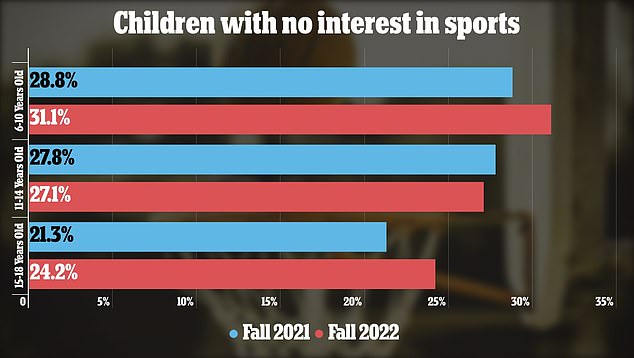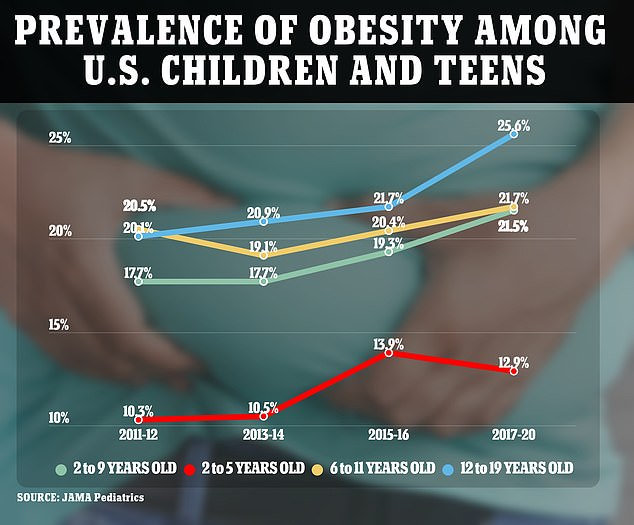Increasing the number of children playing sports by just 25 percent by 2030 would save the country tens of billions of dollars in medical costs, a report claims.
Less than a quarter of American children ages six to 17 get the recommended hour of physical activity every day, a figure that has been trending downward for decades, while youth obesity has skyrocketed and now affects one in five children.
A study led by researchers at the City University of New York (CUNY) found that increasing the number of children playing sports by 25 percent over the next five and a half years would lead to savings of $80 billion, 1.71 million fewer cases of overweight/obesity and 352,000 cases of weight-related diseases such as type 2 diabetes and heart disease.
In March 2020, it took just a few days for schools and after-school sports programs to cancel sporting events out of concern for student health. But four years later, the number of kids rejoining their teams is lower than researchers and doctors would have expected.

The Covid pandemic, which forced millions of children to give up time with friends and extracurricular activities, caused a widespread loss of interest in sports that persists today.


Increasing youth participation in sports from the current 50.7 percent to 63.3 percent could decrease overweight and obesity rates by 3.37 percent, resulting in approximately 1.71 million fewer cases .
The researchers even predict that simply increasing participation from its current level to pre-Covid (58.4 percent) could save a staggering $29.17 billion.
The 2030 goal is part of the government’s Healthy People initiative launched in 1979, which sets 10-year national goals and objectives aimed at improving the health and well-being of Americans.
The latest study was led by researchers at the City University of New York (CUNY) who used a computer simulation of American children ages six to 17 to show the long-term benefits of reaching the goal of increasing one’s current level. of youth participation in sports. .
Marie Martinez, CUNY expert and author of the study He said his is the first study to quantify the impact of sports participation on children’s physical and mental health as they grow.
He said: “Not only is this useful in showing the current and future impact of increasing sports participation, but it can also help decision makers determine how to invest and allocate resources to increase participation.”
In addition to representing youth participation in sports, the computational model they used simulated and tracked weight-related health problems, such as diabetes, stroke, heart disease and some types of cancer that they are likely to experience. throughout his life.
Increasing youth participation in sports from the current 50.7 percent to 63.3 percent could decrease overweight and obesity rates by 3.37 percent, resulting in approximately 1.71 million fewer cases .
Additionally, achieving this goal could also add more than 1.8 million years of healthier life to people.
And improved physical health from increased participation in youth sports could prevent an estimated 352,000 cases of weight-related diseases such as type 2 diabetes, coronary heart disease (CHD), stroke, and various forms of cancer throughout the world. life of children from 6 to 6 years old. 17.
The downstream effects include massive healthcare savings amounting to $22 billion in direct medical costs and more than $25 billion in lost productivity due to improvements in physical health.
The researchers also said that physical well-being is not the only facet that would improve if more children were physically active and participated in sports.
They reported that overall reduction in symptoms of depression and anxiety by achieving the Healthy People 2030 goal could save $3.61 billion in direct medical costs and mitigate productivity losses amounting to $28.38 billion across the entire youth population.


Childhood obesity rates in the US increased 17% between 2011 and 2020, with people ages 12 to 19 most at risk


Achieving the Healthy People goal by 2030 is projected to add more than 1.8 million years of healthier life to young people.
Tom Farrey, executive director of the Aspen Institute’s Sports and Society Program, founder of Project Play and co-author of the study, said: “We are dangerously close to having a nation in which the majority of children no longer play organized sports.”
“We need help from public health, education, government, philanthropy and other sectors that influence children’s lives – those who will reap many of the benefits and cost savings of getting and keeping more children in the game “.
His report was published in the American Journal of Preventive Medicine.
Researchers’ sense of urgency to boost youth sports participation is a result of sky-high rates of youth obesity in the U.S. that have shown no signs of stopping.
An estimated 21.5 percent of Americans between the ages of two and 19 were obese in 2020, according to a report published in JAMA Pediatrics. That marks a 17 percent increase from previous data collected in 2016.
The Covid pandemic, which saw millions of children abruptly diverted to distance-only learning and forced to give up extracurricular activities and time with friends, has had a persistent impact on young people’s sports participation, but signs indicate it is coming a return to normality, albeit slowly. .
game project 2022 report shows that the number of hours children spend playing has returned to pre-pandemic levels.
Children ages 5 to 18 spent an average of 16.6 hours per week on sports activities in September 2022, compared to 13.6 percent before the pandemic and 7.2 percent in June 2020.
Still, an increasing number of children are not at all interested in playing sports.
In May and June 2020, about 19 percent of parents said their children’s loss of interest in playing would likely prevent them from resuming sports when the pandemic was under control.
That figure increased to 28 percent in fall 2021 and remained stable at 27 percent in fall 2022.
